What is time? Few things are so familiar and mysterious. Our lives are governed by time, and yet we have so little understanding of it.
In many ways time behaves like a dimension. We move through and have a position in time, just as we move through and have a position in space. Every event, happening, and meeting can be specified by its temporal and spatial coordinates.
But unlike dimensions of space, we have no say over our speed and direction in time. We can neither stop nor turn around. We only go forward, unalterably, at the rate of one second per second.
Adding to the strangeness of the time dimension, we even measure it differently. While we use rulers to measure distances in space, measuring distances in time requires clocks.
But until 1905, no one had any idea just how strange time really is.
This was the year Einstein overturned the millennia-old notion that time is an absolute, fixed, and independent aspect of the universe.
He showed that time is relative, malleable, and dependent on observers.

Contents
The miracle year
One person, in one year, revolutionized physics.
A then 26-year old Albert Einstein, published four papers in 1905. They established 20th century physics as we know it.
This year is called Einstein’s miracle year:
- March: Explained the photoelectric effect: discovered photons
- May: Explained Brownian motion: established existence of atoms
- June: Published special relativity: showed time is not what we thought
- September: Proved mass-energy equivalence: mass is energy
Nearly every equation in physics describes relationships between time, space, energy and mass. With these papers, Einstein revised our understanding of them all.
Some millennia-old ideas were vindicated, others vanquished.
Einstein proved the existence of atoms, which had remained an unproven theory since the time of the ancient Greeks. Together with mass-energy equivalence, the atomic age was born.
Einstein also settled an equally long-standing debate as to whether light was composed of particles or waves. By showing that light is made of particles, he established the field of quantum mechanics. Most of our electronic and digital technology is based on quantum mechanics. (See: “Does everything that can happen actually happen?“)
But perhaps, the most significant paper of Einstein’s miracle year was “On the Electrodynamics of Moving Bodies“. It established special relativity, and flipped on its head our understanding of space and time.
Special relativity
Any of Einstein’s miracle year papers could have earned a Nobel Prize. But in 1921, the prize committee chose to award Einstein not for special relativity, but for his paper on the photoelectric effect.
Special relativity, and its consequences, were just too strange.
In the 1920s, decades after Einstein published his theory, still no experiment had been done to confirm it. And so, while believed true by most physicists, special relativity remained controversial.
Overturning tradition
Special relativity overturned an idea espoused by Newton, and believed since Euclid — who established geometry in 300 B.C.
This was the idea that time and space are absolutes. Meaning, they are constant, fixed, independent of all things, and universally agreed upon.
If time is absolute then everyone should agree on the order of events. Moreover, everyone should agree on what exists and happens in the present moment of time. Absolute time also implies that time flows at the same rate for everyone.
But relativity forces us to give up all these ideas. The rate time flows, the order of events, and even the content of the present are no longer absolutes, but relative. Different observers may disagree on all these facts, but they can all be right — from their own relative viewpoints.
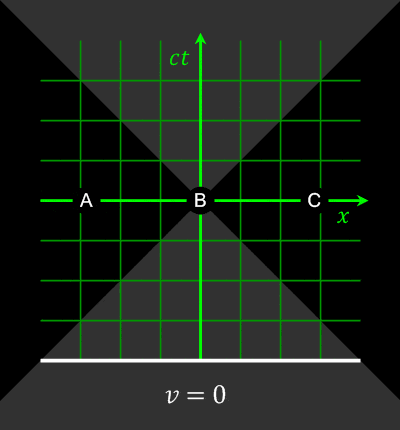
Under relativity, time is not a rigid clockwork that runs the universe. It melts away to something more mercurial. Time becomes something that we can alter our speed and direction through.
Strange predictions of special relativity
If we thought time was strange, it only gets stranger with relativity.
Relativity can be traced to a thought Einstein had at 16. He wondered: what would it be like to ride alongside a beam of light?
By the age of 26, Einstein had worked it all out. But the consequences were bizarre. Special relativity made the following predictions:
- The faster something goes, the slower time passes for it. (time dilation)
- The faster something goes, the shorter it becomes. (length contraction)
- Clocks agreeing at rest, disagree in motion. (clock desynchronization)
- The order of events in time is not absolute. (relativity of simultaneity)
In Einstein’s theory, the speed of light is absolute. Every observer agrees on the constancy of the speed of light. But for this to be true, we must abandon space and time as absolutes.
When time is not absolute, observers can disagree on the rate time flows and we get time dilation. Likewise, when space is not absolute, observers can disagree on distances and we get length contraction.
Together, this creates disagreement on what happens when and where, leading to clock desynchronization and relativity of simultaneity.
To appreciate the strangeness of relativity’s predictions, it helps to play around with the calculator below.
Special relativity calculator
Try velocities such as: 0, 0.1, 0.5, 0.95, 0.999, and 1.
Time Dilation:
Length Contraction:
Clock Desynchronization:
Speeds we generally consider high, like the speed of sound, are slow compared to the speed of light. An object breaking the sound barrier travels at just 0.0001% the speed of light.
Since relativistic effects are negligible when velocities are small, it took decades before any of these predictions could be tested.
Confirmations of special relativity
As incredible as these predictions were, over the 20th century, all of these effects of relativity have been confirmed in experiments.
In fact, every day you might confirm relativity without realizing it.
Technologies, like GPS, would not be possible without accounting for time dilation. That car batteries work at all is due to effects of special relativity within lead atoms. Relativity accounts for many chemical properties, like why mercury is a liquid and why gold is yellow.

Each time you hear a car’s ignition, see the glint of a gold ring, or use GPS to get somewhere, you reconfirm Einstein’s theory.
Is the speed of light constant?
All predictions of special relativity follow from two assumptions.
The first is that the laws of physics work the same regardless of one’s speed or direction. The second is that the speed of light is constant for all observers, regardless of their speed or direction.
This is known as “The Principle of Invariant Light Speed“.
Though it seems innocuous, this is what leads to the strange effects predicted by relativity.
You might consider yourself to be at rest right now. But you, along with our galaxy, are moving at speeds over a million miles per hour!
| Relative Motion | Speed (km/h) |
|---|---|
| Earth around its center | 1,670 |
| Earth around Sun | 107,230 |
| Solar System around Milky Way | 828,000 |
| Milky Way through the Universe | 2,100,000 |
Earth spins at over 1,600 km/h around its axis. It also circles the Sun at over 100,000 km/h. Earth, together with the rest of her solar system, orbits the galactic center at nearly a million km/h.
Further, our galaxy and neighboring galaxies are falling towards an unseen mass called the Great Attractor at over two million km/h.
But regardless of our direction of motion through space, or the angle from which we measure it, the speed of light is always the same.
Ranging the moon
The Moon is circling the Earth at 3,679 km/h.
With the winding orbit of the Moon around Earth, the Earth circling the Sun, and Earth’s daily spinning, the relative motion and position between the Earth and the Moon is always changing.
Sometimes the Moon is behind us, other times it’s ahead, and at still other times, it’s to our side. Despite these changes, scientists find no difference in how long it takes for light to get to the moon and back.
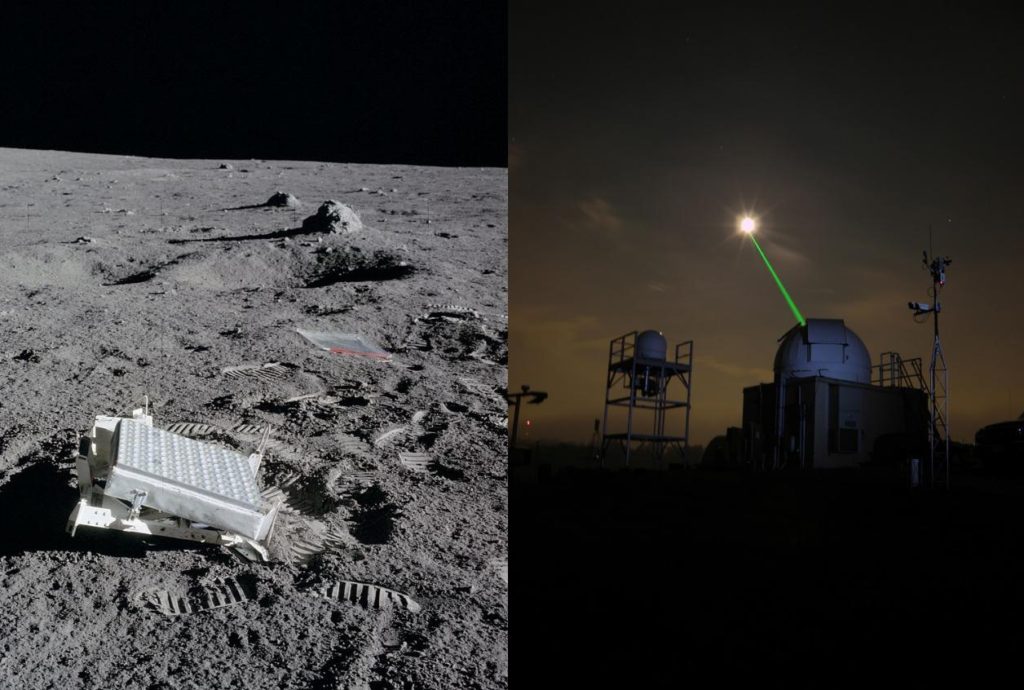
Right: Scientists on Earth can bounce lasers off these mirrors to get a return signal.
Image Credit: NASA
Scientists have measured how long it takes a laser beam to go to the moon and back. The beam is bounced off retroreflectors, which like the reflectors on bikes, reflect light in the direction it came from.
Only one photon in 10^{17} makes it back, but this is enough for us to measure the distance to the Moon to the precision of a millimeter.
It’s a stunning confirmation of the Principle of Invariant Speed of Light.
Regardless of the speed, direction, or relative motion between the Earth and Moon, the time it takes for light to get to the moon and back is the same, and so we conclude the speed of light is the same.
Measuring Time
Directly testing some predictions of relativity is difficult.
Since effects like time dilation are negligible when not traveling close to the speed of light, confirming it requires either very fast vehicles, or very accurate clocks — or perhaps some combination.
It’s easy to forget that in 1905, cars were the fastest vehicle and the most accurate clocks were based on pendulums. The 20th century saw great improvements in both vehicle speeds and clock accuracy.
All clocks are based on resonators. Something that cycles at regular intervals. Clocks count these cycles or “ticks” to measure time.
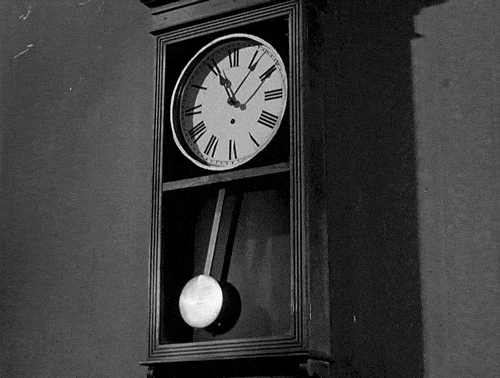
In grandfather clocks, the resonator is a swinging pendulum. In mechanical watches, its a bouncing spring. In digital clocks, its the electrically-stimulated vibrations of a quartz crystal.
Given manufacturing defects, these methods are only so accurate.
No two pendulums, springs, or quartz crystals are exactly alike. And further, differences in temperature or pressure can throw them off.
Atomic clocks
All atoms of the same isotope are identical. As early as 1879, Lord Kelvin proposed using atomic resonances to keep time.
But it was not until 1955, several months after Einstein’s death, that the first accurate atomic clock was built.
Every atom preferentially absorbs specific frequencies of light. Therefore we can use atoms to tune light to exact frequencies.
Once the light is tuned by these atoms, we can build a clock that counts the oscillations of the light wave.
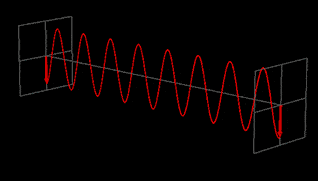
Image Credit: Best Animations
The cesium-133 isotope was chosen to be used in all atomic clocks. Cesium was selected for having a lone electron in its outer shell. This makes it especially sensitive to excitation.
While a stopwatch might track seconds to 3 decimal places, atomic clocks track seconds to 10 decimal places. The light wave that cesium absorbs best ‘ticks’ 9,192,631,770 times per second.
These clocks provided sufficient accuracy to directly test time dilation.
Time Dilation
Time dilation is one of the stranger predictions of special relativity. It says that the faster something moves the slower it experiences time.
If one of two synchronous clocks at A is moved in a closed curve with constant velocity until it returns to A, the journey lasting t seconds, then by the clock which has remained at rest the travelled clock on its arrival at A will be \frac{1}{2}tv^{2}/c^{2} seconds slow.
Albert Einstein, in “On the Electrodynamics of Moving Bodies” (1905)
Time doesn’t just seem to go slower. It actually passes more slowly — by every physical measure. Clocks run slower, radioactive atoms decay slower, and life forms age and metabolize slower.
If you were subject to time dilation, you wouldn’t notice, because even your brain activity and thought patterns would operate more slowly. But if you were to later meet up with someone who didn’t undergo time dilation you would find they have aged more than you.
This leads to the famous twin paradox, where according to special relativity one of two identical twins goes on a high-speed space voyage and returns to find their sibling significantly older.
Testing time dilation
Despite the strangeness of time dilation and what it leads to, it has been tested and confirmed as a genuine phenomenon.
The first evidence came in 1932 with the Kennedy–Thorndike experiment. However, the evidence was indirect.
In 1907, Einstein said one way to directly test it is to look for a transverse Doppler effect in light from a fast-moving source. This effect is due to time dilation experienced by a moving light source.
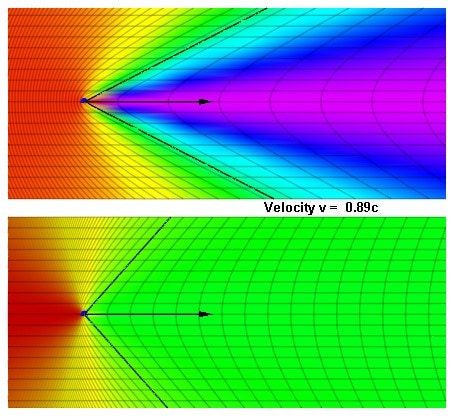
Image Credit: Wikimedia Commons
It took experimenters 30 years to figure out a way to test this. Technology to accelerate flashlights to near light speed didn’t exist.
Experimenters had to get creative.
Herbert Ives created the color fax machine in 1924 and the video phone in 1927. In 1938, Ives, together with his colleague, G.R. Stilwell, designed and executed the first experimental test of time dilation.
The two built a device that used electrodes charged to 43,000 volts to accelerate charged hydrogen ions to 0.5% the speed of light. These atoms were charged by stripping them of an electron. When a charged atom reclaims an electron, it releases a particle of light.
In effect, single hydrogen atoms acted like miniature flashlights. It was enough to confirm Einstein’s prediction. It was also the first direct confirmation of special relativity — 33 years after it was published.
Twin Paradox
Does time dilation really apply to such things as people? Could time dilation really cause a person to age less?
It seems absurd, but according to the theory, a trip on a fast rocket would allow one twin to age 5 years while the other ages 50.
To test this, engineers needed either a very fast vessel, or a very accurate clock — or perhaps some combination of each.
With the rise of commercial air travel in 1952, and the invention of the atomic clock in 1955, it became possible to test the twin paradox.
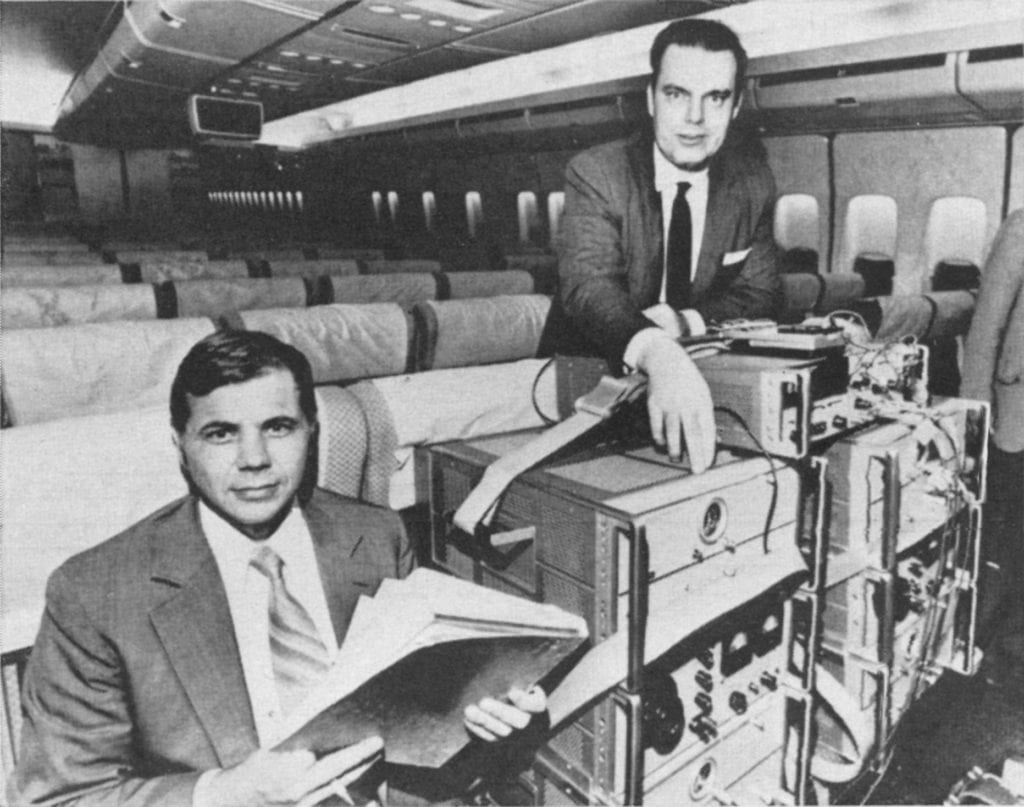
In 1971, two experimenters, Joseph Hafele and Richard Keating flew around the world with a pair of atomic clocks.
After the trip, Hafele and Keating compared the time on their clocks to the time of atomic clocks that were left behind. The clocks they brought with them now ran behind the clocks that stayed home.
The clocks, and accordingly the people that stayed put aged more! Hafele, Keating, the pilots, the plane, and the clocks they took with them all aged less — by about 50 nanoseconds.
It was a small effect, but enough to notice using atomic clocks. The amount of time they lost was exactly what relativity predicted.
Time dilation is real.
Time dilation and GPS
You verify time dilation every time you use GPS.
GPS is based on extremely accurate time keeping.
When GPS detects you moved over by one foot, it did so by noticing the radio signal from one of these satellites now takes 1 nanosecond longer to reach you. The more precise the clock, the more precisely GPS can determine your location.
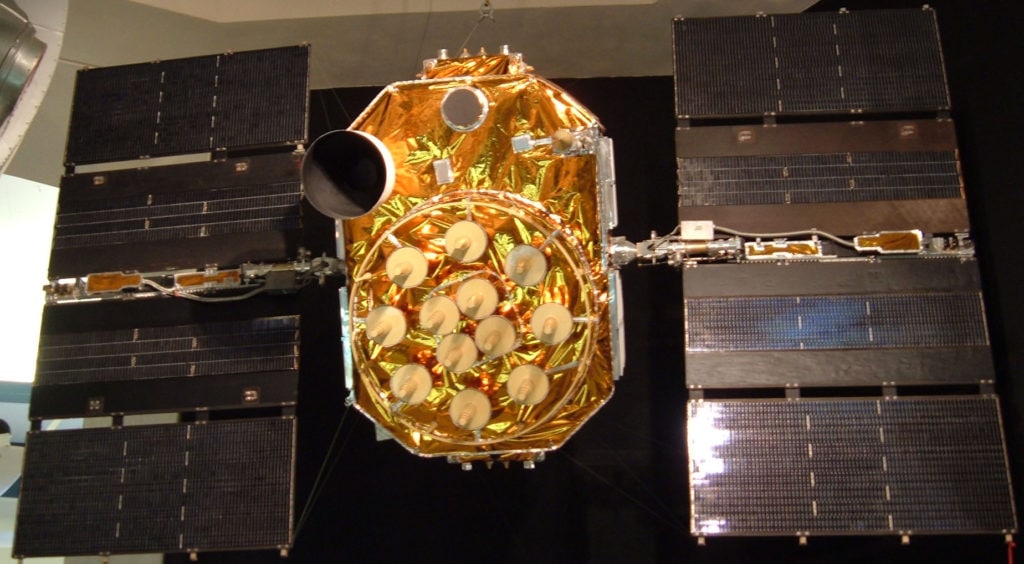
To keep its rhythm, each GPS satellite has its own atomic clock on board. But to remain in orbit, each satellite has to move at a very high speed: approximately 4 kilometers per second — about 9,000 mph.
At this speed, relativity predicts the clocks will run slower by 7 microseconds a day. It seems insignificant, but this loss of time would throw GPS off by about 2 kilometers a day.
GPS would soon be useless.
Fortunately, the designers of GPS knew about time dilation. They took it into account and adjusted the clocks to run faster to compensate for this effect. Given that GPS works with these adjusted clocks confirms that we experience time differently than GPS satellites do.
Significant time dilation
For Hafele and Keating flying around the world, and for GPS satellites, the loss of time amounts to just fractions of a second.
But these differences in time are only negligible because the speeds are negligible compared to the speed of light.
The lost time is small because compared to the speed of light the speed is small. Jets travel at just 0.0001% the speed of light, and GPS satellites at 0.00134%.
But at 98% the speed of light, time is dilated by a factor of 5. That means we experience 5 seconds for each second experienced by an object travelling at 98% light speed.
At 99% the speed of light, time passes 7 times slower.
Under relativity, there is no limit to how much slower time can run — it is only a matter of how close to light speed you can get.
Photons, which travel at the speed of light, experience no time at all. To a photon, the entire history of the universe unfolds in an instant.
Particle accelerators
Technology to accelerate objects to great speeds now exists.
In fact, if you have an old TV that isn’t a flat screen, it contains technology that accelerates particles to 10% the speed of light.
But modern particle accelerators can do better.
The Large Hadron Collider, the world’s most powerful particle accelerator, can accelerate particles to 99.9999991% the speed of light. At this speed time passes 7,454 times slower.
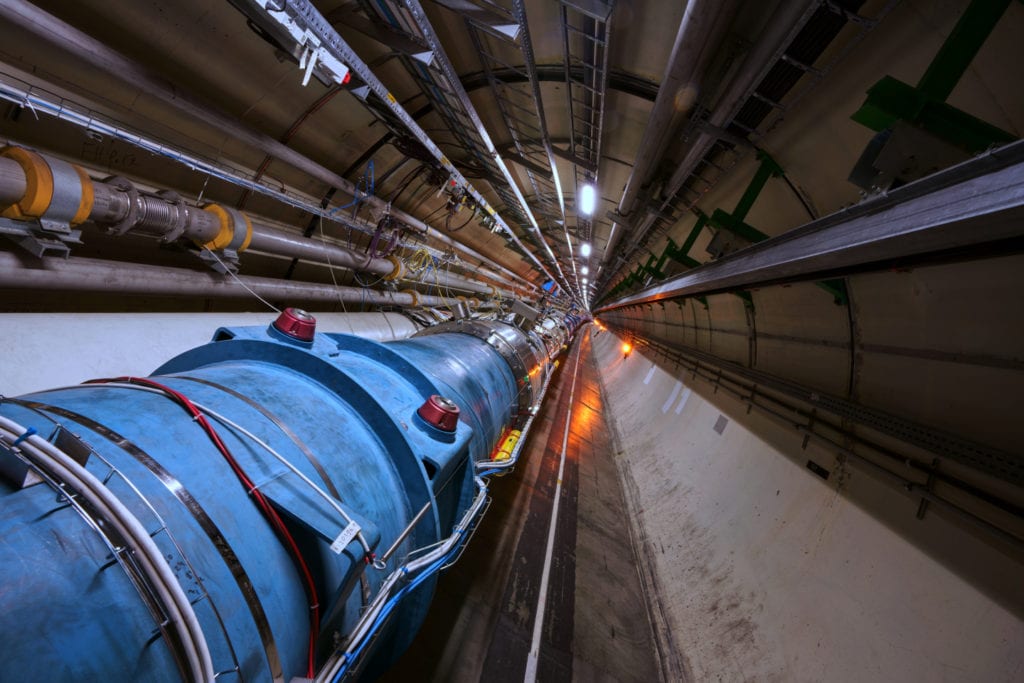
Significant time dilation effects have been confirmed.
Though we can’t yet accelerate large objects like clocks, to near the speed of light, unstable particles can serve as miniature clocks.
For instance, we might use muons. They are unstable particles with an average lifetime of 2.2 microseconds.
In 1977, researchers at CERN accelerated muons to 99.941% the speed of light. At this speed, they observed the muons survived an average of 64 microseconds — almost 30 times longer than usual.
This confirms the twin paradox. A person accelerated to this speed would age 30 times slower than the rest of us left on Earth.
But there is a problem. How can the speed of light be constant for everyone when, according to relativity, not everyone experiences time in the same way? Speed, after all, is distance divided by time.
Length Contraction
The only way for the speed of light to be constant for everyone when observers measure time differently, is if observers also measure space, (distances and lengths), differently.
This leads to relativity’s prediction of length contraction.
Atmospheric muons
Let’s consider the case of a muon created in the upper atmosphere by a cosmic ray collision. We’ll assume it travels straight down to Earth from where it formed, 15 kilometers overhead.
At the muon’s speed of 99.5% the speed of light, it will take 50 microseconds to cross this 15 kilometer distance and reach Earth.
This time is well beyond the average life of the muon, which is just 2.2 microseconds. And yet, experiments show that due to time dilation, this muon has a good chance of surviving to reach Earth’s surface.
But from the muon’s own frame of reference, it is at rest and Earth is coming towards it at 99.5% the speed of light. How can the muon have a chance of lasting 50 microseconds it will take for Earth to run into it?
This is because the muon experiences space differently.
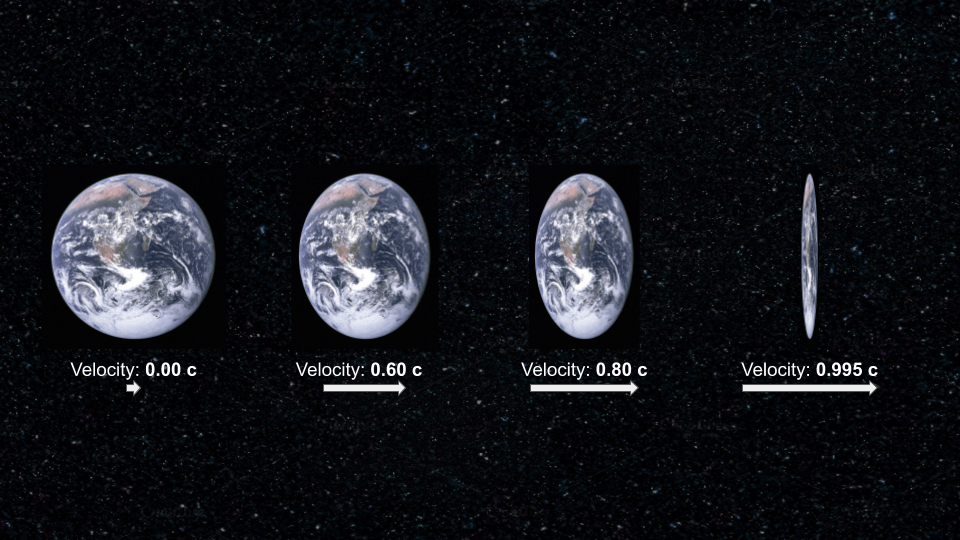
From the muon’s point of view, the entire Earth is flattened, squished along it’s direction of travel. At a velocity of 99.5% the speed of light, the length shrinks by a factor of 10.
Instead of being 12,000 kilometers wide, Earth appears just 1,200 kilometers wide. Earth’s atmosphere, instead of being 100 kilometers thick, seems only 10 kilometers thick. The 15 kilometers to the surface, is reduced to just 1.5 kilometers.
These are not optical illusions, but distortions of space. They’re as real as distortions to time caused by time dilation.
Given these spatial distortions, the muon can judge itself to have a good chance of surviving long enough to reach the surface.
Interstellar travel
The corresponding effects of time dilation and length contraction arise in interstellar travel. Should we put people on a rocket that accelerates to 99.5% the speed of light, those astronauts would experience time at 1/10th the rate we do. A 75-year lifespan becomes 750 years.
At this speed, they could survive a trip to a star 300 light years away. To those on board, the journey takes just 30 years.
But everything remains consistent from the perspective of those on the rocket. They are not violating the speed of light by crossing 300 light years in 30 years time.
Instead, the distance (and all of space) between Earth and this star contracts by a factor of 10. To them, the star is 30 light years away, and so at near the speed of light they arrive in 30 years.
Whenever there is time dilation, there is length contraction. They are two sides of the same coin. It is also mutual. To those on Earth, we see their rocket ship as contracted to 1/10th its length before it launched.
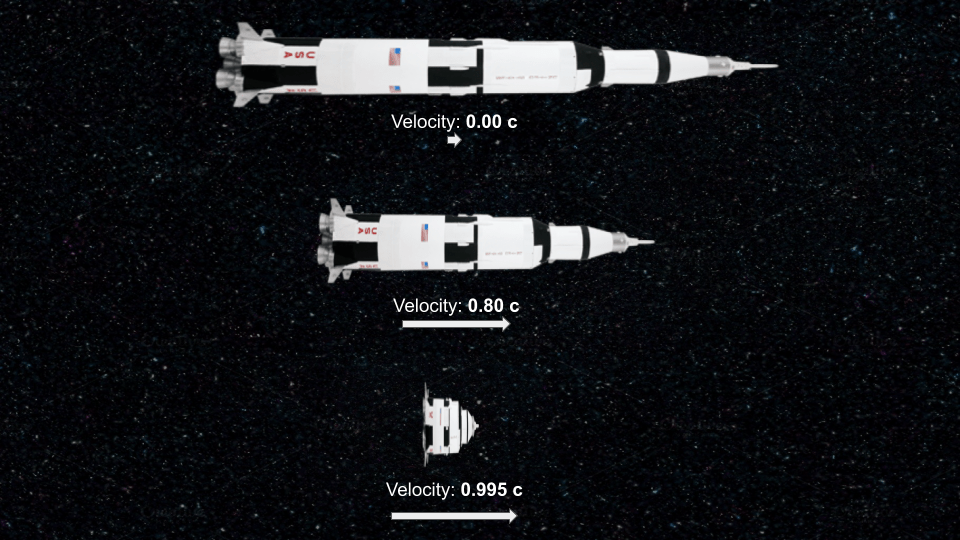
By making the speed of light a universal constant, we must give up time and space as universal constants. Instead, observers moving in different speeds or directions disagree on both time and space.
Length contraction on atomic scales
Many doubted whether these effects were genuine physical phenomena. Einstein, however, defended the view that these effects were real and could be demonstrated.
The question as to whether length contraction really exists or not is misleading. It doesn’t “really” exist, in so far as it doesn’t exist for a comoving observer; though it “really” exists, i.e. in such a way that it could be demonstrated in principle by physical means by a non-comoving observer.
Albert Einstein, 1911
Using particle accelerators, researchers at the Relativistic Heavy Ion Collider accelerate the nuclei of gold atoms to 99.995% the speed of light. At this speed, the normally round atomic nuclei become length-contracted by 100-fold, and appear as flat pancakes.
The outcomes of these collisions can only be explained by accounting for the increased density of the nucleus caused by length contraction.
Length contraction on astronomical scales
Aside from looking for the length contraction at the smallest scales, we can also look upwards to find astronomical confirmations. We can see the effects of length contraction in some of the largest objects.
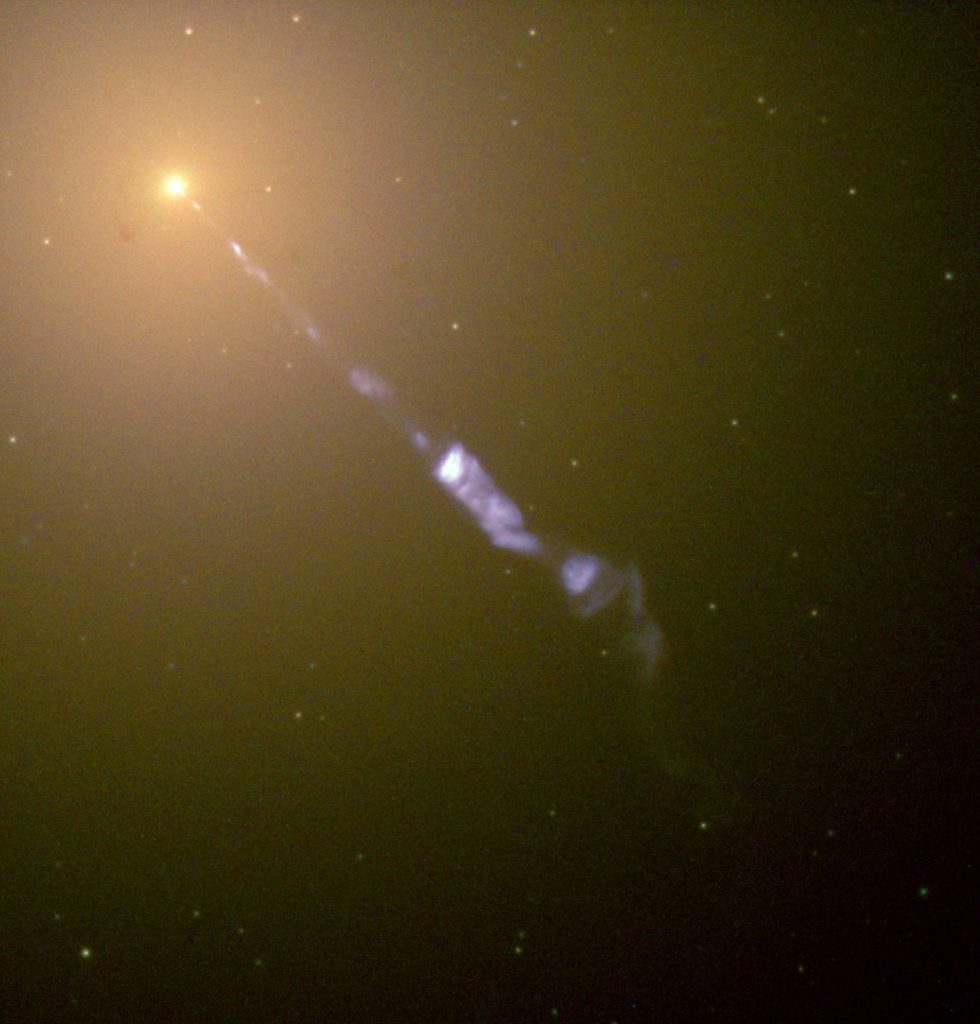
The M87 particle jet, travelling near the speed of light, has a blue hue due to length contraction. Length contraction has a multiplying effect on the frequency of the emitted light in the direction of travel.
This jet emanates from one of the largest celestial objects ever photographed — a black hole 6.5 billion times heavier than the Sun.
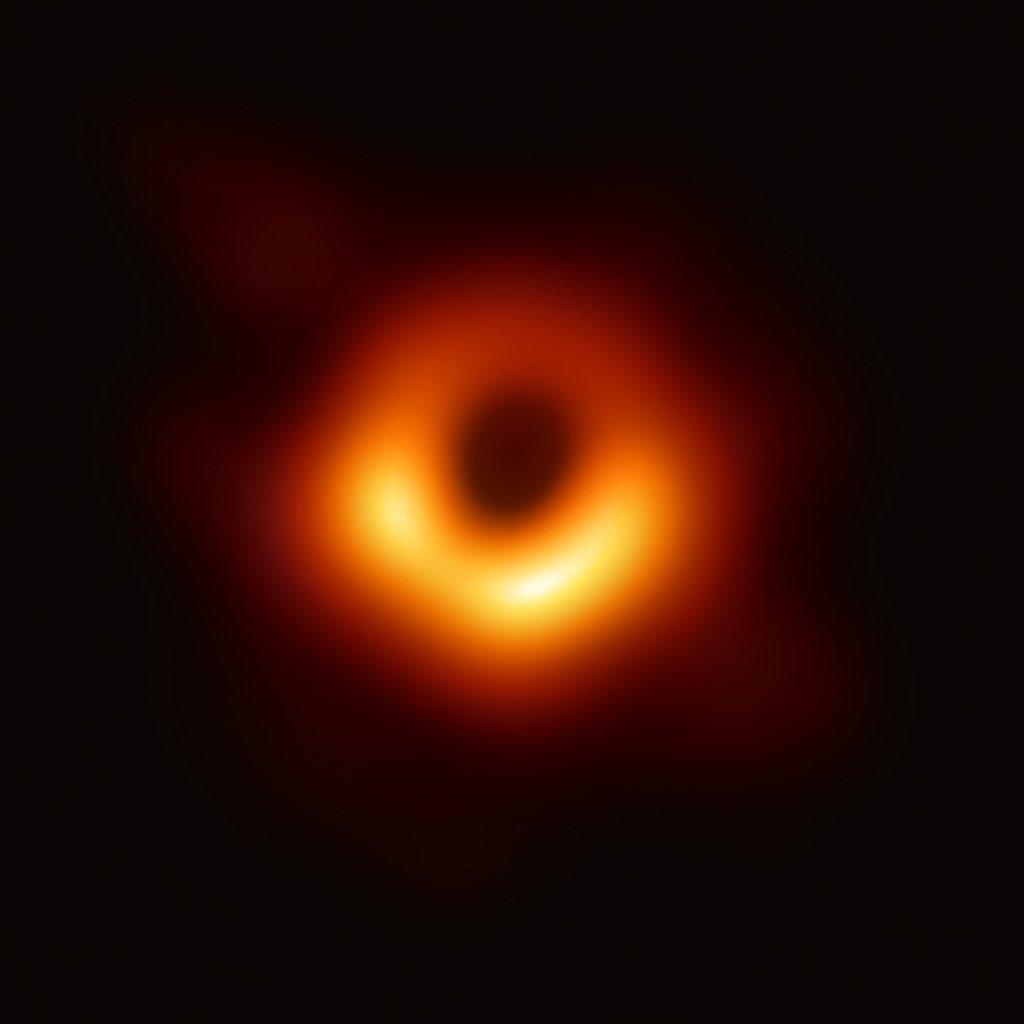
Image Credit: Event Horizon Telescope
This is the same black hole famously photographed in 2019.
Understanding special relativity
How could reality be so strange? How can it be that time and space can flex and bend so radically from one person’s view to another’s? Actually, it all makes perfect sense, once we understand what time really is.
Spacetime
When an object, say a 100-meter long rocket, is accelerated to 60% of the speed of light, its length decreases to 80% of its length when at rest.
An object’s length at rest is known as its proper length.
But this formerly 100-meter rocket, at this speed is just 80 meters long. What happened to its extra length? Where does it go?

Length contraction is an effect of rotation. It is analogous to tilting an umbrella formerly pointed straight at the sun: it’s shadow contracts along the direction the umbrella is tilted.
Spacetime and length contraction
Likewise, the 3-dimensional “shadow” or projection of an object rotated in 4-dimensional space contracts. But what could this extra 4th dimension be that objects rotate in? According to relativity, it’s time!
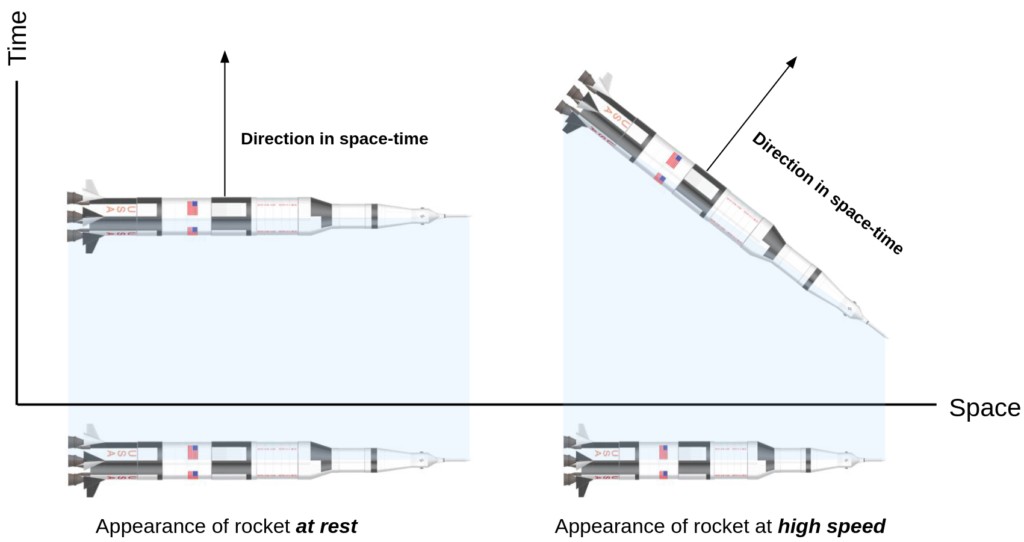
The phenomenon of length contraction is therefore an artifact of rotating an object in this unified view of space and time (spacetime). We see the 3-dimensional shadows of what are really 4-dimensional objects.
The rocket’s length in spacetime does not change. An object’s spacetime length always equals its proper length.
So according to relativity and this spacetime view, when the rocket is at rest it uses all of its length to reach through space. But when accelerated, it uses some of its length to reach through time.
This suggests that space and time are measures of the same thing. All physical objects that reach through space, when in motion, reach through time. Time is just another dimension of space, like width, height, and depth. It is the 4th dimension.
This is why physicists created the word spacetime. Rather than treat time and space separately it embodies the unified whole.
The views of space and time which I wish to lay before you have sprung from the soil of experimental physics, and therein lies their strength. They are radical. Henceforth space by itself, and time by itself, are doomed to fade away into mere shadows, and only a kind of union of the two will preserve an independent reality.
Einstein’s professor Hermann Minkowski, in Space and Time (1909)
Spacetime and twins
This spacetime model not only provides an intuitive understanding of length contraction, but also explains time dilation and the twin paradox. Take for example, the case of two twins Sam and Pam.
Sam stays on Earth for 10 years while his sister Pam travels to the star Proxima Centauri and back at 80% the speed of light.
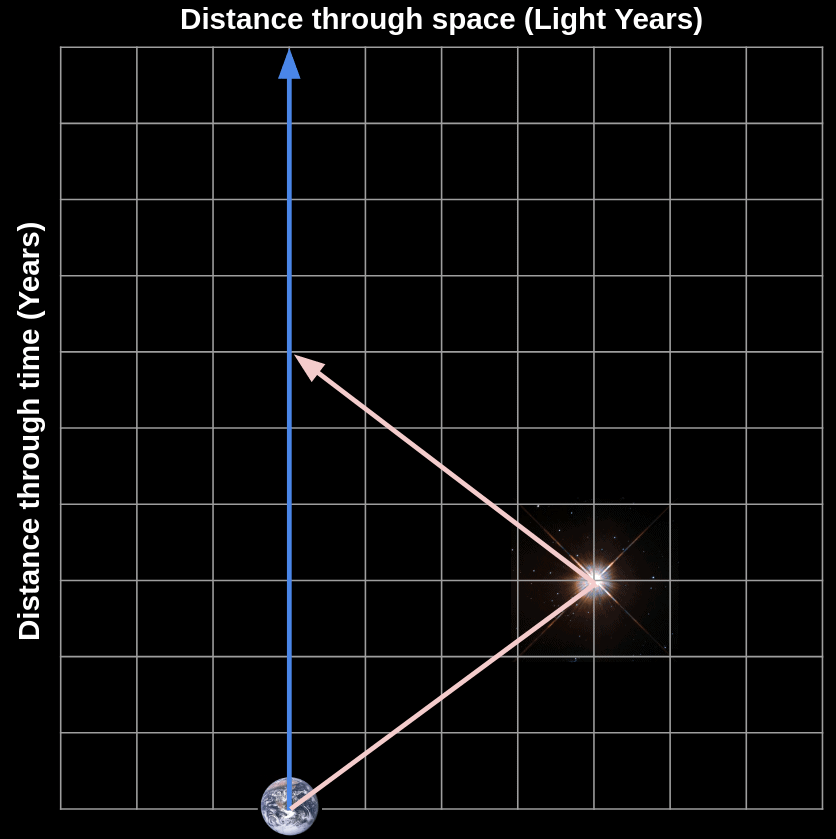
The proper length of both Sam’s and Pam’s paths through spacetime is 10 light years, but because Pam used 80% of her speed to travel through space, she could only use 60% of her speed to “travel through time”. So while Sam aged ten years, Pam aged only six.
While observers may disagree on distances in space, or distances in time, all observers agree on distances through spacetime.
Like the speed of light, spacetime lengths are absolute.
Clock Desynchronization
The rotation of objects in four dimensions suggests an entirely new phenomenon: clock-desynchronization.
Clock desynchronization is different from time dilation. Clock desynchronization is the effect where two clocks that agree when at rest, will disagree on the time when they move.
This applies even when the clocks move together. For example, when on the same rocket. But when the rocket comes to a halt, the two clocks will once again agree on the time.
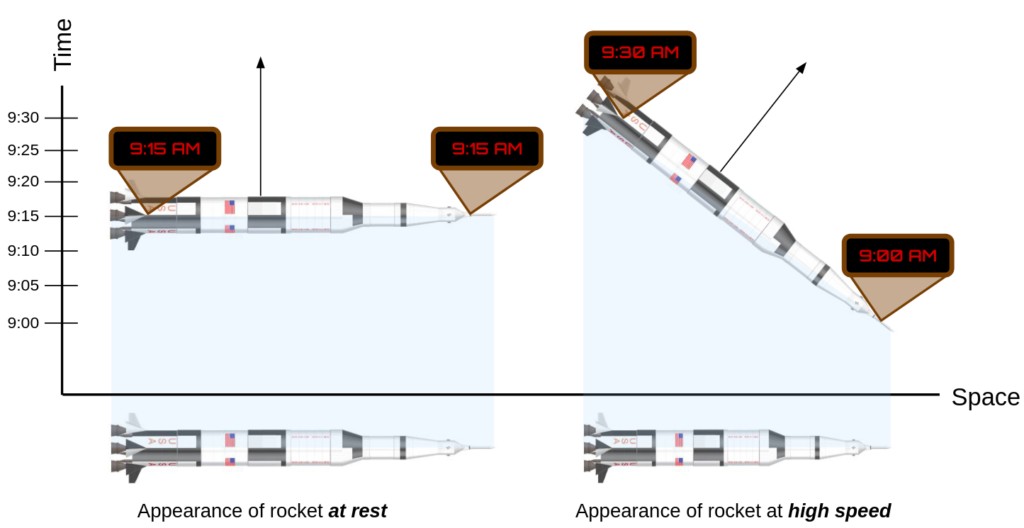
Each end of the rocket is in a different time and of a different age. The rocket really does reach through time.
In the case of clock desynchronization, rulers can measure time, and clocks can measure lengths! It is another confirmation that time and space are made of the same stuff and are units of the same thing.
When converting units of space and time, such as when measuring distances in spacetime, the conversion is straightforward: 1 light year is 1 year, 1 light second is 1 second, 3.33 microseconds is 1 kilometer, and 1 nanosecond is about 1 foot.
You could say that when an object seems to be at rest, in actuality it is traveling through time at the speed of light.
Why can’t you travel faster than light? The reason you can’t go faster than the speed of light is that you can’t go slower. There is only one speed. Everything, including you, is always moving at the speed of light. How can you be moving if you are at rest in a chair? You are moving through time.
Lewis Carroll Epstein, in “Relativity Visualized” (1981)
Relativity of Simultaneity
Clock desynchronization implies a still stranger phenomenon.
The relativity of simultaneity.
Are two events (e.g. the two strokes of lightning A and B) which are simultaneous with reference to the railway embankment also simultaneous relatively to the train? We shall show directly that the answer must be in the negative.
Albert Einstein, Relativity: The Special and the General Theory, (1916)
Observers can even disagree on the order in which events take place.
One observer might believe events A and B happened at the same time. Another can conclude A happened before B, and a third could consistently determine B happened before A.
Moreover, all three are correct — from their own frames of reference.
For example, consider two stars in our night’s sky, Betelgeuse, in the constellation Orion and Eta Carinae in the constellation Carina.

Both are supergiant stars near the end of their lives. When they die, they will explode as brilliant supernovae.
For several days afterwards, they could appear as bright as the moon and be visible during the day, as was the case in the supernova of 1054.
If by chance, Betelgeuse and Eta Carinae go supernova at the same time from our point of view, then according to relativity, there are others who will conclude that Betelgeuse went supernova first, and still others who will conclude that Eta Carinae went supernova first.
This has nothing to do with the time it takes light to reach us. We assume scientists on Earth, and Aliens on other worlds took all of that into account when they calculated when the stars went supernova.
The disagreement stems from an effect of rotation in spacetime — as in case of clock desynchronization. It is clock desynchronization paired with the fact that different observers can have different relative speeds compared to a pair of clocks.
A pair of clocks that appear synchronized from one point of view can from another point of view, appear desynchronized.
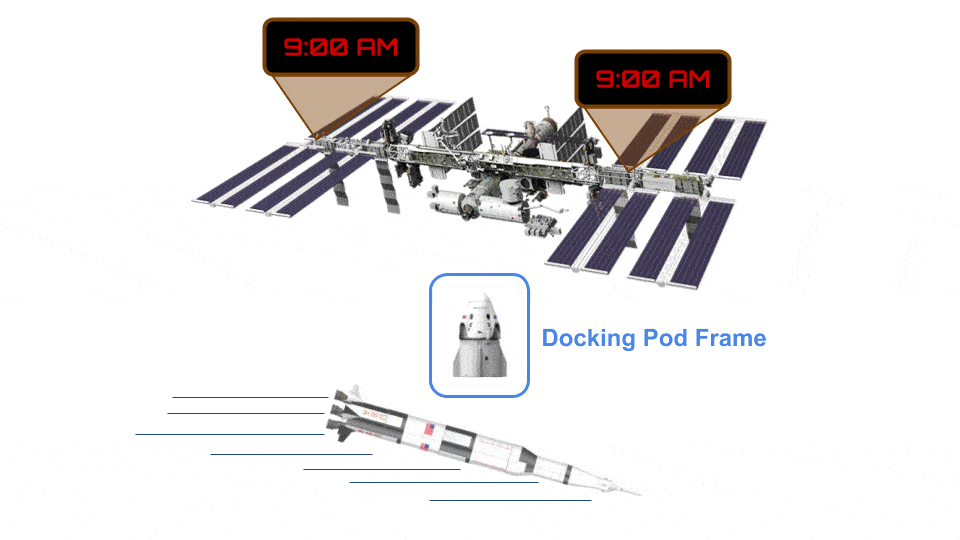
From the rocket ship’s frame, it is at rest while the station and docking pod fly by in the opposite direction. In this frame, the station and pod are rotated in spacetime. Accordingly, the rocket ship sees the clocks as desynchronized: the clock on the right strikes 9:00 AM before the clock on the left.
If a rocket flies rightwards by a space station while two clocks on the station simultaneously strike 9:00 AM, those on the rocket will not consider the strikes to be simultaneous. They will consider the clock on the right to strike 9:00 AM before the clock on the left.
Likewise for another rocket travelling in the opposite direction, it would see the clock on the left strike 9:00 AM before the clock on the right. Hence we get three different, but nonetheless equally valid, interpretations on the order of the events.
How can this be?
Events in spacetime
The breakdown of a consensus comes down to the fact that space and time are not absolute. Asking “what event happens first?” is like asking “what seed comes first in an apple?”
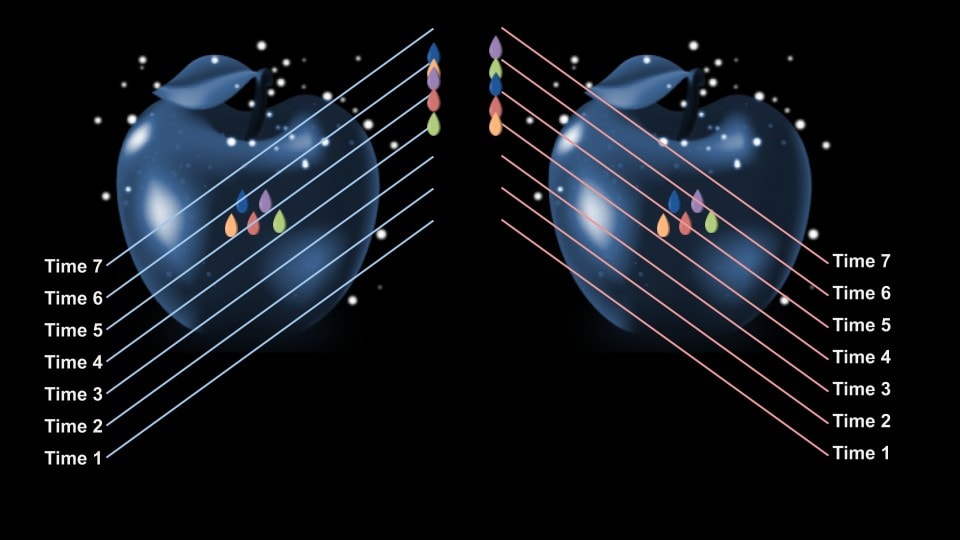
Events are embedded in spacetime like seeds are embedded in apples. There is no absolute ordering to the seeds. The order you encounter them depends on the angle you choose to slice through the apple.
In relativity, one’s direction through spacetime determines this “slicing angle”. It explains why different observers, travelling at different speeds or directions through spacetime disagree on the order of events.

Image Credit: Wikimedia
Evidence of four-dimensional spacetime
Could reality be so strange?
It seems so. Relativity of simultaneity is an inevitable consequence of special relativity. Without it, the ladder paradox can’t be explained.
Moreover, scientists have confirmed the existence of clock desynchronization and it’s associated relativity of simultaneity through the observation of the Sagnac effect.
This effect is the basis of a technology civilization depends on.
If you’ve ever flown on a commercial jet or used a product delivered by a commercial ship, you’ve taken advantage of technology based on relativity and effects that produce clock desynchronization.
This technology is the ring-laser gyroscope.
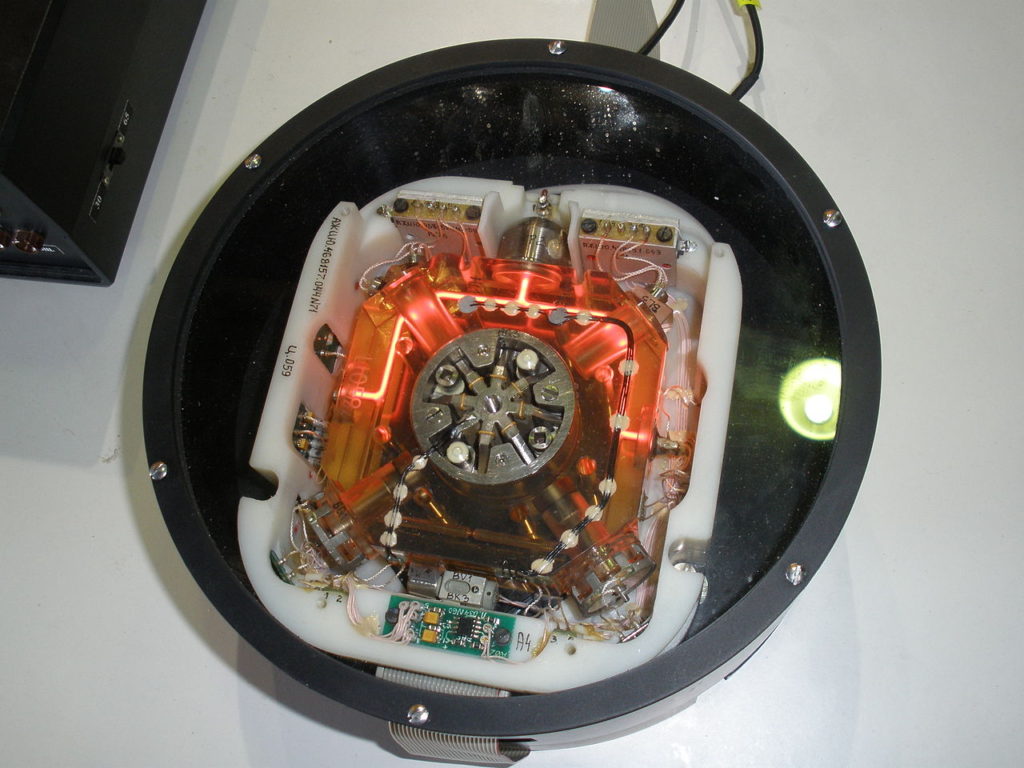
Aside from improved reliability, ring-laser gyroscopes are extremely sensitive. They can detect rotation speeds as small as 0.00001 degrees per hour. To put this in context, a clock’s hour hand rotates at 30 degrees per hour — 3 million times faster.
Interchangeability of time and space
We’ve seen that time and space are made of the same stuff.
Length contraction shows yardsticks can reach through and measure time. Clock desynchronization shows clocks can measure distance.
In 1948 Richard Feynman took this idea and ran with it. He created what came to be known as Feynman diagrams — diagrams that detail physical interactions between particles.
Feynman diagrams show that in every physical interaction, space and time are completely interchangeable.
For instance, the following Feynman diagram shows the same physical interaction between an electron (e) and a photon (γ):
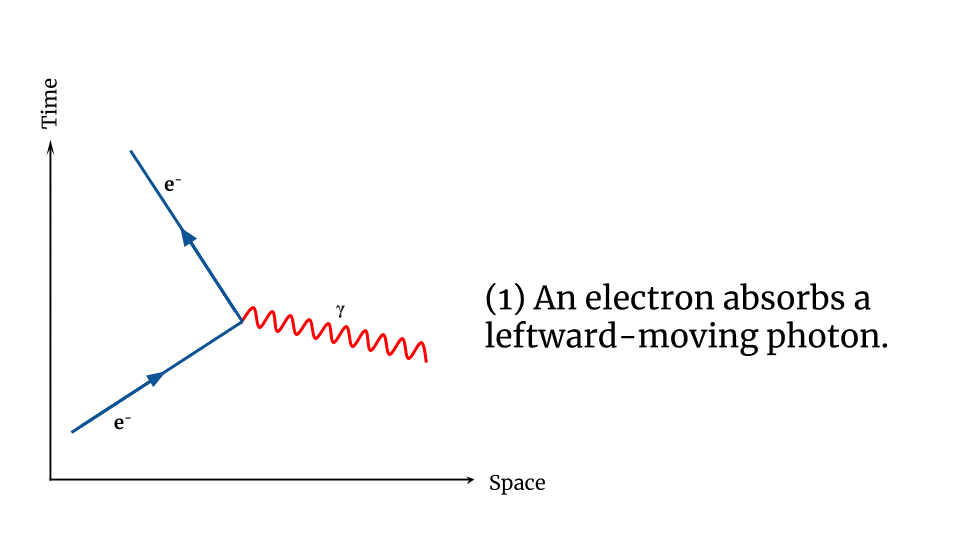
Depending on how we perceive this interaction rotated in spacetime, we can describe this same interaction very differently.
This one interaction can variously be described as:
- The absorption of a photon by an electron
- The emission of a photon by an electron
- Electron–positron antimatter annihilation
- The emission of a photon by a positron
- The absorption of a photon by a positron
- Electron–positron pair production
But in all cases, it is the same picture of the same interaction, just approached from different angles; seen to unfold in different ways.
Messages from the future
Accordingly, the physicists Ernst Stueckelberg and Richard Feynman independently suggested that antiparticles (particles of antimatter), are simply regular particles travelling backwards in time.
For example, the positron (also called an anti-electron) can be considered an electron travelling backwards through time.
The only difference between an electron and a positron is how it moves through spacetime, relative to us.
If valid, this is an indication that the future is real.
Antimatter is often considered an exotic material of science fiction. But antimatter was first discovered in 1932 by the physicist Carl David Anderson, earning him the 1936 Nobel Prize in physics.
Today antimatter is used as the basis of several technologies.
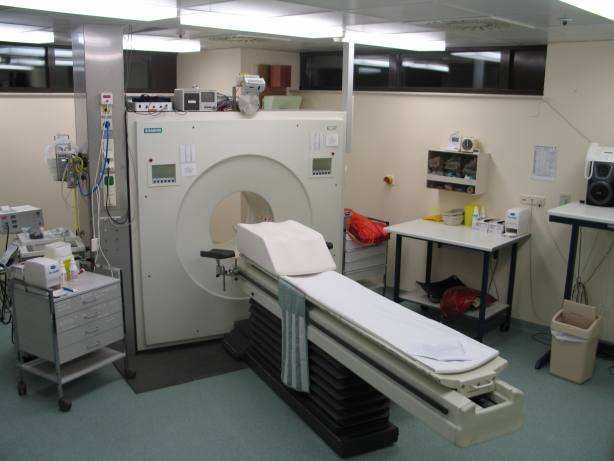
You don’t have to go to a hospital or physics lab to find antimatter.
There is a good chance that you can obtain antimatter from your local supermarket. Due to the radioactivity of bananas, caused by the unstable potassium-40 present in them, the average banana has roughly 1.2 million radioactive events per day.
Of those, about 1 in 100,000 produces a positron. Therefore each banana emits about 12 positrons a day — or one every 2 hours.
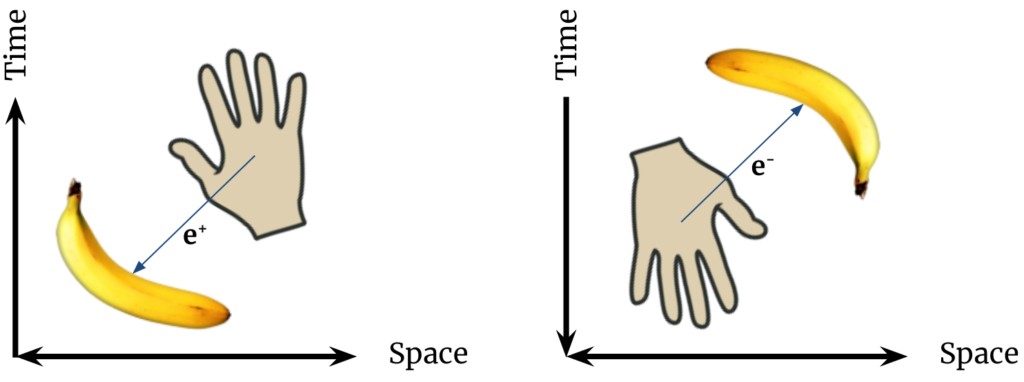
Under the Feynman–Stueckelberg interpretation, the banana receives a “message from the future” in the form of an electron sent back in time. If you’ve ever wanted to own a time machine, you need only visit your local grocer. (See: “Is time travel possible?“)
The future has already happened
In the 1960s, scientists started to realize that if the core tenet of relativity is true — that there are no privileged reference frames — then the past, present, and future must all be considered equally real.
The physicist C. W. Rietdijk in 1966 and the mathematician Hilary Putnam, in 1967 used relativity to argue on the basis of the relativity of simultaneity that all events, past, present, and future, are equally real.
I conclude that the problem of the reality and the determinateness of future events is now solved. Moreover it is solved by physics and not by philosophy. We have learned that we live in a four-dimensional and not a three-dimensional world, and that space and time–or, better, space-like separations and time-like separations–are just two aspects of a single four-dimensional continuum.
Hilary Putnam, Time and Physical Geometry (1967)
The relativity of simultaneity tells us that any event (in our past or in our future), is in the present according to another reference frame.
So if every reference frame is as valid as any other (i.e. no preferred frames of reference) we must accept the equal reality of all events.
The Andromeda paradox
This idea was best illustrated by the mathematical physicist Roger Penrose, in a description now called the Andromeda paradox:
Two people pass each other on the street; and according to one of the two people, an Andromedean space fleet has already set off on its journey, while to the other, the decision as to whether or not the journey will actually take place has not yet been made.
Roger Penrose, in “The Emperor’s New Mind” (1989)
How can there still be some uncertainty as to the outcome of that decision? If to either person the decision has already been made, then surely there cannot be any uncertainty. The launching of the space fleet is an inevitability. In fact neither of the people can yet know of the launching of the space fleet. They can know only later, when telescopic observations from Earth reveal that the fleet is indeed on its way.
Then they can hark back to that chance encounter, and come to the conclusion that at that time, according to one of them, the decision lay in the uncertain future, while to the other, it lay in the certain past. Was there then any uncertainty about that future? Or was the future of both people already “fixed”?
Here two observers, let’s call them Alice and Bob, are standing right next to each other. They meet at the same time and place: say the sidewalk at noon. However, according to relativity, because they are walking in different directions each belongs to a different present moment. Their presents contain different content.
If Alice is walking in the direction towards the Andromeda Galaxy at 3 mph, then her present contains Andromeda as it is 4 days in our (at rest) future. If Bob is walking away from Andromeda at 3 mph, his present contains Andromeda as it was 4 days in our past.
Given that a week’s time difference separates Alice’s and Bob’s versions of Andromeda, in Bob’s present, aliens in Andromeda might plan to convene and vote on whether or not to launch an invasion fleet on the Milky Way. While in Alice’s equally valid present, they have already voted and the invasion fleet has already launched!
So Alice’s present contains events that are in Bob’s future. Likewise, events in Galaxies Bob is walking towards and Alice is walking away from contain events for Bob that are in Alice’s past.
How can this be?
Understanding the Andromeda paradox
It is merely a consequence of clock desynchronization, played out over astronomical distances. Usually we think relativity only comes into play at very high speeds. But if the distance between clocks is large enough, the time difference can be significant even at low speeds.
The distance between our Milky Way Galaxy and the Andromeda Galaxy is 2,500,000 light years.
Imagine an absolutely huge rocket that reached all the way between Andromeda and the Milky Way. If this rocket traveled at 10% the speed of light, a clock desynchronization of 250,000 years would appear between a clock at the front of this rocket and a clock in the rear. The tail of the rocket would be 250,000 years in the future.
If the rocket traveled at one-thousandth the speed of light, the clock desynchronization would be 2,500 years. If the rocket traveled at just 3 mph, the clock desynchronization would be 4 days.
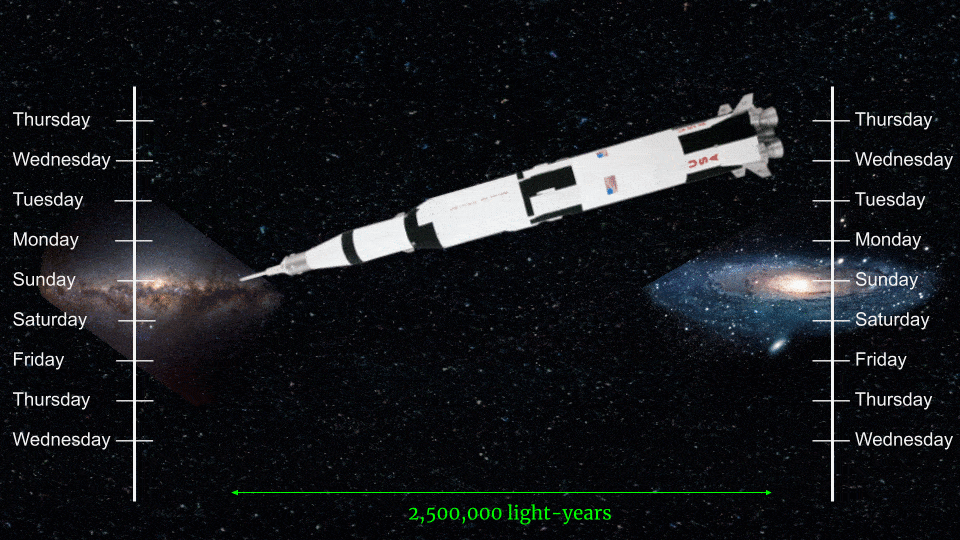
We can understand the Andromeda Paradox once we realize the rocket is not needed. All we need is for Andromeda to be moving relative to us (such as when we walk towards or away from it) for the “time” of Andromeda to run ahead of or behind us.
As it happens, Andromeda and the Milky Way are falling towards each other. They will meet in a great collision 4.5 billion years from now. (See: “How will the world end?“)
Because galaxies are mostly empty space, most stars and solar systems will survive this collision unharmed. Though some may be ejected from the galaxy to drift in the darkness of intergalactic space.
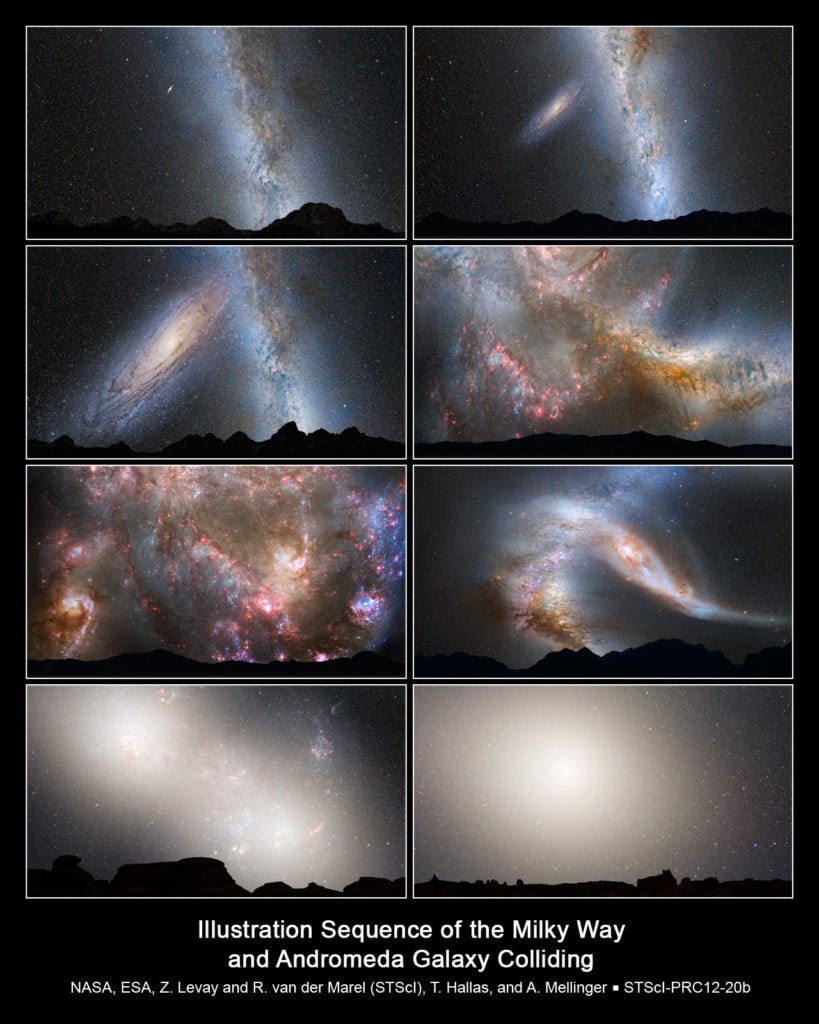
Image Credit: NASA/ESA
Conclusions
Special relativity is one of the most strongly confirmed of all theories in science. But it’s implications go well beyond space and time.
Learning the true nature of time, as described by relativity, fundamentally changes our notions of reality, self, and existence.
In some respects, special relativity’s implications even venture into the religious domains of creation, free will, and eternal life.

Can there be creation when the past, present and future have always existed? What is free will when the future is already decided? Does the existence of events in spacetime mean we possess eternal life?
Let’s review the implications of special relativity in more detail.
Implications for reality
Reality is what’s real. By convention, we assume only the present is real.
But this is not based on any scientific fact; just on how we feel. We feel as though we are moving through time. This feeling makes us believe we are in only the present. Therefore, we think the past no longer exists, and the future is yet to come.
But might this all be an illusion? A trick one’s mind plays on itself?
If we take the implications of relativity seriously, then the past, present, and future hold an equal claim to reality and existence.
Four-dimensionalism
Relativity offers another way to view reality. One wherein every event exists perpetually in its location in spacetime.
It is analogous to how every frame of a movie reel exists, even when not actively projected to a screen.


Within every frame, the horse believes itself to occupy its time — the time it believes is the present. But each horse in each time feels that way. Which one is right? What time is it really?
According to relativity, the word “now” becomes like the word “here”. Neither word reflects a property of the universe, but instead reflects a property of the person speaking it.
Just as we envision all of space as really being out there, as really existing, we should also envision all of time as really being out there, as really existing too.
The physicist Briane Greene in “The Elegant Universe” (1999)
The view that the past, present, and future, are all equally real is known as eternalism (also called four-dimensionalism or block-time).
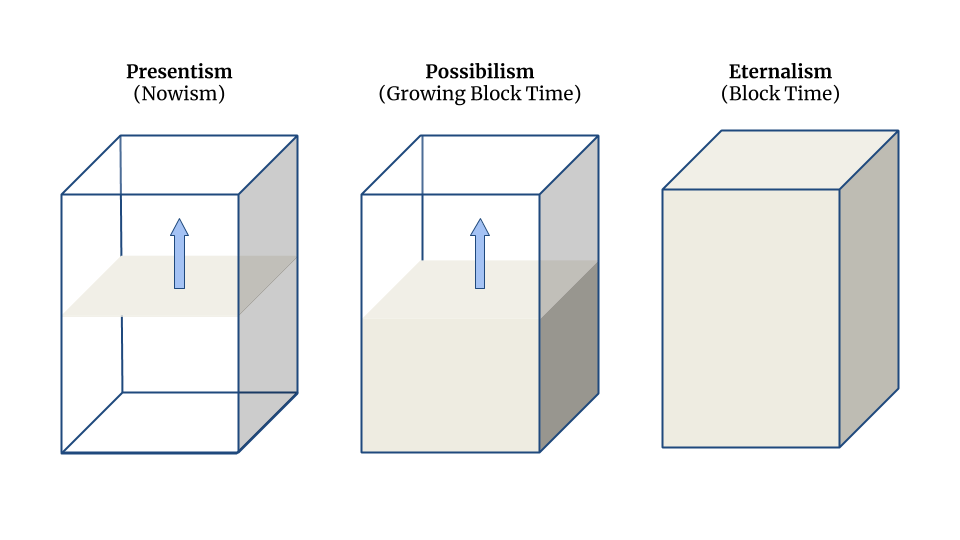
Eternalism follows directly from special relativity.
We have seen length contracted objects can reach through time. They exist in different points in time at once. This is impossible if there is only one present moment.
Further, we have seen the relativity of simultaneity shows there is no single objective present. We each define our own “present” as one particular cross-section cut through the block of spacetime.
But if all points in time exist, what accounts for change? Why do we feel as though we move forward into the future?
Is change an illusion?
Philosophers have long debated whether change is real or illusory.
Some 2,500 years ago, the Greek philosopher Parmenides argued that existence is timeless and any appearance of change is an illusion.
what is, is uncreated and indestructible, alone, complete, immovable and without end.
Parmenides in “The Way of the Truth” (circa 475 B.C.)
Since the time of Parmenides, this question was considered to belong to the domain of philosophers, not scientists. It took science thousands of years, but special relativity has finally proven Parmenides right.
In four-dimensional spacetime, change — as a future coming into being and then disappearing into a non-existent past — doesn’t happen.
It appears therefore more natural to think of physical reality as a four dimensional existence, instead of, as hitherto, the evolution of a three dimensional existence.
Albert Einstein in “Relativity: The Special and General Theory” 15th edition (1952)
This was not just a quirky belief of Einstein. It remains the present understanding of modern physicists.
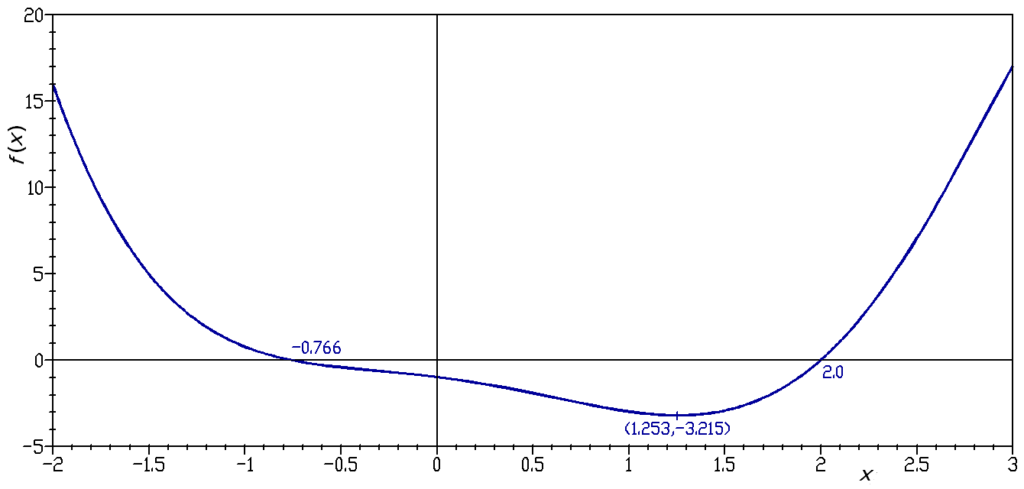
Special relativity provides a framework to understand how events are interconnected within an unchanging four-dimensional structure.
Just as we might say the value of a graph f(x) changes with respect to x, we can say an object’s position p(t) changes with respect to time t.
This accounts for the appearance of change and motion where objectively there is none. All the positions p(t) across all times exist, just like all the points on the graph exist at once.
Why is the future unknowable?
When an object reaches through time, it extends into both the past and future. This means, at some level, the future is real.
We get further evidence of this from antimatter: antiparticles seem to enter our present, arriving from some future point in time.
According to the spacetime view, future events are every bit as real and determined as past events. This means the future is already written.

But if the future is real, why can’t we remember tomorrow?
Time’s arrow
The unknowability of the future has nothing to do with whether or not the future exists. Whether the future exists or not, or is predetermined or not, physics explains why we have no knowledge of it.
It is an artifact of how our brains process and store information.
According to thermodynamics, energy can only be expended in the direction of time along which entropy increases.
Since processing and storing information requires an expenditure of energy, our brains — or anything that uses energy — can only operate in one direction of time:
The direction in which entropy increases — from past to future.

It is the same with systems that process information. They can’t operate going backwards in time. If they could, we might see hard drives manifest pictures taken tomorrow.
Image Credit: Tenor
Since entropy increases from the past to the future, our brains can only operate along that time direction. Accordingly, we can only store memories of the past; memories of the future are impossible.
Our deeply ingrained belief in flowing time and an unknown future is not due to the non-existence of the future, but rather physical limitations on how systems are allowed to process information.
(See: “Why does time have an arrow?“)
Implications for self
Special relativity doesn’t just redefine our picture of reality. It alters the concept of ourselves, as temporary beings moving through time.
It makes us question whether we can even make any decisions at all.
Do we have freewill?
The ideas of determinism, free will, predestination, foreknowledge, and omniscience have historically been deeply intertwined.
Can we exercise a free will when the future is predetermined? What about when future events already exist in spacetime?
Differences of opinion on such questions have even caused divisions between different religious sects and denominations.

For instance, Calvinists believe that God knows in advance who is destined for salvation and damnation. Other denominations believe only in predestination of those destined to be saved.
The question of whether we have free will, and whether free will is compatible with determinism or foreknowledge is nuanced. For a detailed consideration see: “Do humans have freewill?“
Religion and special relativity
Various religions have supposed things about reality and time that aren’t far off from the ideas of special relativity.
Relativity of viewpoints
Within Jainism is a doctrine known as Anekāntavāda meaning “the relativity and multiplicity of views.” It is the idea that there is no absolute viewpoint of reality. Rather reality can be perceived differently according to different points of view.
Jains also believe that the universe is uncreated and eternal.
Existence of all times and events
In Hinduism, Om (also Aum), signifies Brahman, the ground of being.
The unchanging Om is the All. Its expansion is, what has been, what is, what shall be. And what is beyond the three times, is also Om. For all this is the Eternal; and this Self is the Eternal; and this Self has four aspects.
Mandukya Upanishad (c. 200 A.D.)
Religions that consider God to know the future often describe future events as already existing — at least existing within the mind of God.
God, owing to His infallible prescience of the future, has appointed and ordained from eternity all events occurring in time, especially those that directly proceed from, or at least are influenced by, man’s free will.
The Catholic Encyclopedia
Eternal life
Relativity tells us no single point of view regarding time, space, or motion is more correct than any other. All views are correct, from their own frames of reference.
This means the present time is not some fact of the universe, but merely an opinion shared by contemporaries.
This fact implies eternal life, and a form of immortality.
Caesar still lives
Consider the case of Gork, an alien from Andromeda. Gork owns a fast spaceship that can travel 240 kilometers per second — about 17 times faster than our Voyager space probes.
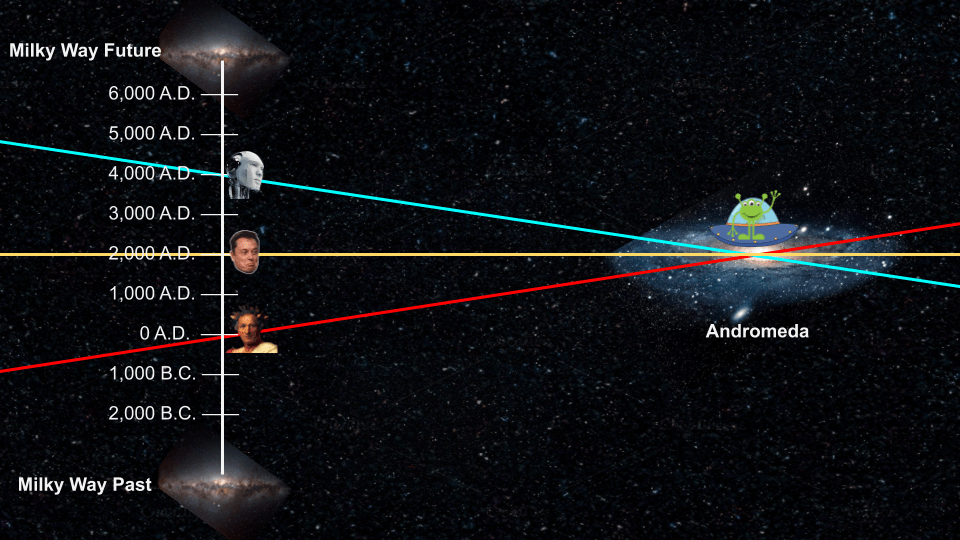
From Gork’s perspective in Andromeda, you could either be:
- Not yet born.
- Alive and reading this article, or
- Long dead.
It all depends on which direction his ship is going.
How can our present, ancient Rome, and the far future all exist? Only with a four-dimensional reality can we make sense of this.
Accordingly we must dispense with the idea that time flows or that there’s an objective present. In this revised view, Julius Caesar is alive — he’s just in a location 2,000 light years behind us in spacetime.
From Caesar’s viewpoint, the present is a little before 0 A.D. and none of us are yet born. Our opinion that he is long dead doesn’t bother him — no more than the opinions of people born in 4000 A.D. bother us.
There exist times long before you were born and times long after you died. But despite the opinions of people in those other times, you are here, alive and well, within the time span of your life.
Similarly, those who are dead or are not yet born (from our perspective) feel the same — alive and well in their own times.
Its no coincidence the present year happens to be a time during your life, rather than a billion years in the past or future. You will always find yourself in a point in time where you exist.
Relativity has brought physicists to this conclusion. Rietdijk, who proved that relativity requires four-dimensionalism, wrote:
Of course, man is four-dimensional, just like all other organisms and objects. This mere situation implies that there is a life after death, namely, that part of the four-dimensional human being that exists after the moment of his death.
C.W. Rietdijk in “Four-dimensional reality continued” (2018)
Humans have spatial borders. We have a height, breadth, and depth. Humans also have temporal borders. These borders stretch through spacetime from one’s birthday to the day one dies.
A 70-year lifespan extends 70 light years through spacetime — forming a long thin spiraled helix, winding 70 times around the sun.
That is our true nature, as four dimensional beings.
A tenacious illusion
The common view of time, as something pressing forward, leads many to assume they will cease to exist once this “moving present” passes beyond the day they die.
Relativity reveals this fear to be unsupported, for it implies a perpetual and eternal existence of all locations and times.
Fearing that you cease to exist because you have a future temporal border is as silly as fearing you cease to exist because you have spatial borders, or a temporal border in the past.
What exists is not just one present moment, but the “whole apple” or the entire “movie reel” — all of spacetime. Every moment of the past, present, and future.
This view has been expressed by eminent scientists, including Albert Einstein, Hermann Minkowski, Wim Rietdijk, Hilary Putnam, Richard Feynman, Roger Penrose, and Briane Greene.
But if before and after are not absolute, what does that imply for the afterlife? What is an afterlife if there is no after?
On this question, Einstein revealed his thoughts.
Michele Besso was a lifelong friend to Einstein. They met as students in Zürich. Besso helped Einstein get a job at the Swiss patent office.
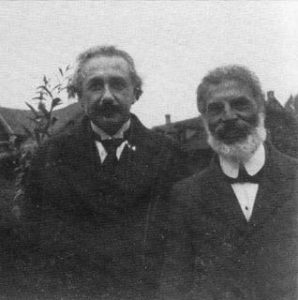
Besso also helped Einstein to develop his ideas. He was the only person Einstein credited in his paper on special relativity.
As Einstein lay on his deathbed, approaching his own temporal border, he received word that Besso died. He wrote a letter of consolation to Besso’s family, writing in part:
Now he has again preceded me a little in parting from this strange world. This has no importance. For people like us who believe in physics, the separation between past, present and future has only the importance of an admittedly tenacious illusion.
Albert Einstein, in a letter to Besso’s family (1955)
Einstein departed from this strange world on April 18th 1955. Just weeks after writing that letter.
Einstein believed that death has no importance because the difference between the past, present, and future is only an illusion.
Many religions promise eternal life. If special relativity is true, you already have it. You exist eternally. Your life is yours forever.
Make it a good one.




I discovered a new simple time formula. As it is known, every simple
physics formula explains a law of nature. My formula says, ‘In a
physical process, a certain amount of time emerges as much as the
amount of energy in that process.’ that is, “The more energy there is,
the more time there is.’ Please can you evaluate my website and
articles? my website timeflow.org and three articles,
https://magneticuniverse.com/discussion/307/timeflow-theory-by-salih-kircalar
Special Relativity Theory (SRT) equations revealed that mass and time are
proportional.
t / t’ = m / m’
My ‘Timeflow’=’Time’/’Energy’ Formula makes a small but important
contribution to this. It expresses that the relation of mass to time is equal
to the amount of mc2 energy of the mass, which is 9×10’16 s or
2,851,927,903.26… years for 1 kg of mass outside the gravitational fields.
Very small free particles in space must be observed by organizations such as NASA or ESA, only then my proposal will be verified.
In addition,The flow of the thought energy intensity in our brain is
body pain, unhappiness and boredom, joy and joy, happiness and love,
sleep, and finally death, respectively, from low to low. At the moment
to sleep, if we had a good sleep, our thought energy is very close to
zero or zero. When the energy flow intensity increases in our brain,
according to the ‘Timeflow Formula (Timeflow=Time/Energy). The
timeflow will slow down. As the energy density (power) decreases, the
timeflow will accelerate. In the case of sleep and death, the timeflow
will be infinite. The timeflow formula explains very clearly and
simply that this situation, which is perceived as psychological time
is actually a purely physical event. I think it would be very useful
for psychology experts to evaluate the ‘Timeflow’ Formula and the
philosophical interpretation of the formula.
Hi Salih,
If by time you mean measurable change, then it is true that maximum rate of measurable change is proportional to the mass-energy of the measured system.
In the planned article on the ultimate physical limits of technology, I will elaborate upon this idea further. For some references on this concept, and how it relates to upper bounds on computation, see: https://arxiv.org/abs/quant-ph/9908043
The final conclusion is that the maximum clock speed (in terms of operations per second) of a computer is based on its mass. In other words, the “Δt” of the system (See: https://en.wikipedia.org/wiki/Bremermann%27s_limit ) is inversely proportional to the mass of the computer. The more mass-energy something has, the faster it changes, which implies it experiences more change (or more ‘timeflow’ — if I am using your terminology correctly).
Jason
Hi Jason,
Many thanks for your interest. The unchanging law is this; Time is revealed as much as the amount of energy. Real time is ‘Time’/’Timeflow’=’Energy’. The most important result that the formula explains is that the lifetime of mass or energy is equal to its mC2 energy. Lifetimes increase as mC2 increases and vice versa.
Thanks
Salih
Hello again Jason,
‘Time Flow’ increases (accelerates), ‘Time’ utilization decreases. That is ‘Time’ decreases. And vice versa. I think this explanation is important.
Best Regards
Salih
Dear Mr. Jason Resch
please have you already somewhere seen graphical Cylic Timeline – or better : Day – Time Symbolic Scale – also as ” Day – Time Rhytm Visualising ” – Philosophy ? I would be glad to find somebody who suggested (too) some graphicaly visualisation with this (Nature-) Symbols Elements.
Thank you very much
Sincerely
Ondrej M a z a n
Author
also Facebook : Ondrej M a z a n
Hi Ondrej,
I am aware of some cyclic cosmologies (e.g. The Big Bounce model, as well as the Wheel of Time and Nataraja). My next article actually has some sections on them. I am not sure I am familiar with the one that you are describing. Do you have links to them I could check out? Thank you.
Salam alaikum
You make many interesting points, as Allah willed.
Time is relative, is quite clear in The Quran.
The Earth is expected to throw up its chronicles, which might be something like you imagine future to past movement.
Time is probably a variable, local, observer-dependant property, which may explain the emphasis on the observation-based lunar calendar.
And so on…
I enjoyed going through your article. May Allah bless you.
Hi Samiya Illias,
Thank you very much! I am glad you enjoyed the article.
A question regarding the Andromeda paradox…
If walking away from the Andromeda galaxy at 3 mph places someone on the same “now line” as Andromeda 4 days in the past what happens if we instead use a galaxy much farther away where instead of the now line being 4 days in the past the now line is for example 20 billion years in the past or even 200 billion years in the past? Given infinite space we could pick a galaxy so far away that walking away from it at 3 mph would place the now line quadrillions of years in the past.
How can we have a now line intersecting through a region of spacetime prior to the big bang?
This must imply that time stretches eternally into both the past and future, if there are galaxies infinitely far away from us then we can have now lines intersecting infinitely into the past.
Dear Zelex,
That is a fascinating line of reasoning! Often new physics are discovered when we attempt to stretch our existing theories to their breaking point as you appear to have done.
I do not know what the answer is, but I can perhaps point you in the direction of some potential resolutions:
A) The first might be that in the context of the big bang, we might view it as not only the origin of space, but also as the origin of time. And as we trace events farther back in time, we ultimately leads to a past where the universe was more and more compact. This may lead to a situation where we lose the physical meaning of these very far away places, because the universe would “shrink in size” faster than we can meaningfully reference the far away galaxies. This video might provide some context to what I am describing: https://www.youtube.com/watch?v=K8gV05nS7mc
B) There may not be any fundamental problem. For an observer in a different reference frame than the universe as a whole, it may be a consistent picture to view the big bang as something that did not happen all at once everywhere at the same time, but as something which (to them) appears to move across in a wave, happening earlier in time in some places, and yet to happen in other places. This is a nonstandard view, but I am not certain it automatically leads to any inconsistency. General Relativity, for instance, adds some additional complexity where dimensions of space and time can be interchangeable and distorted in a way that what appears as time to one observer, may be space to another. It would be interesting to consider your extension to the Andromeda paradox under the view of space and time provided by the theory of inflation, which Alan Guth describes here: https://www.youtube.com/watch?v=rfeJhzPq3jQ
C) In some theories, such as quantum mechanics or eternal inflation, there are times that exist before the big bang, though the physical states represented by these times may be difficult or impossible to define. For example, Sean Carroll writes:
“The Schrödinger equation has an immediate, profound consequence: almost all quantum states evolve eternally toward both the past and the future. Unlike classical models such as spacetime in general relativity, which can hit singularities beyond which evolution cannot be extended, quantum evolution is very simple. […] If this setup describes the real world, there is no beginning nor end to time.” ( https://arxiv.org/pdf/1802.02231v2.pdf ) and for inflation, as explained here: https://www.youtube.com/watch?v=chsLw2siRW0
A) If space is infinite now then it has always been infinite. Unless space was once finite and grew in size at infinite speed (becoming infinitely large instantaneously) then I don’t see how this explantion changes anything in any meaningful way, it merely changes the nunbers of zeros in the calculations.
Unrelated to this topic but this line of reasoning is why I don’t believe in black holes containing singularities (a point of infinite density). Before the core of a star collapses the density as extreme as it may be is still finite, in order for a true singularity to form then the density must become infinite instantaneously, or in other words the matter in the core of the star must collapse at infinite speed which would violate the speed of light.
So I believe that things which are currently infinite were always infinite and things which are currently finite will always remain finite.
B) If we use establisbed science and sound logic to determine that we can have now lines intersecting into spacetime coordinates prior to the big bang then I believe this is evidence of the big bang not being the beginning of all things but rather some kind of phase shift.
C) This option seems more plausible to me, if we can accept that space extends infinitely then why not expect time to extend infinitely? If space and time are inseparably linked and interchangable (spacetime) then if one is infinite in extent then the other should be as well, if one is finite while the other is infinite then interchangeability is impossible.